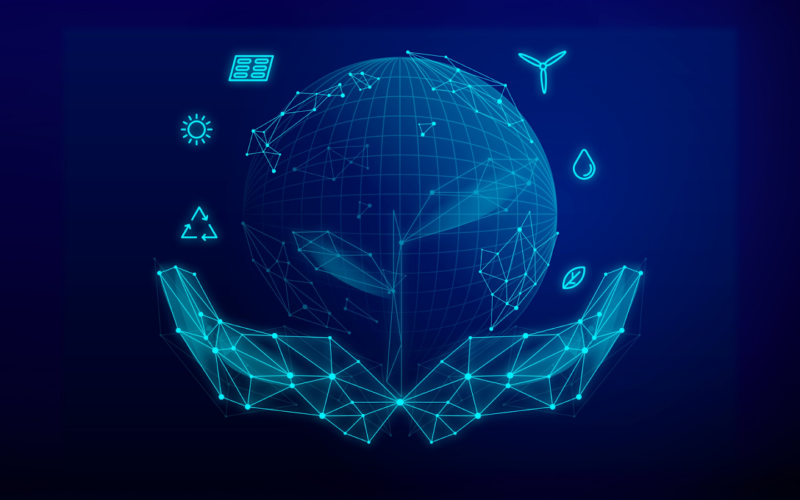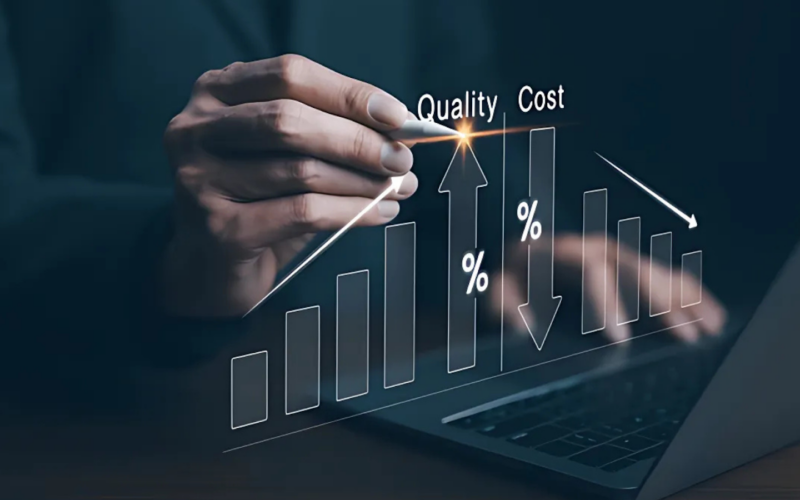Do you find it challenging to scale AI across your business while maintaining your sustainability targets? You’re not alone. Many enterprises are eager to deploy AI for automation, customer insights, and predictive analytics; however, the environmental cost is becoming increasingly difficult to ignore.
AI-driven data center power usage is expected to double by 2026, which could directly derail corporate carbon reduction strategies.
This is no longer just about adopting advanced technologies; it is about ensuring responsible growth. As a business leader, you are likely weighing how to harness AI’s capabilities for efficiency and revenue while meeting ESG mandates, reducing waste, and controlling energy consumption.
In this blog, we will explore AI sustainability solutions for enterprises that directly address these challenges. These include, but are not limited to, computer vision improving workplace safety, as well as ESG-focused AI development, driving measurable, long-term impact.
Key Takeaways
- AI sustainability solutions for enterprises are becoming increasingly essential, as data center power usage is projected to double by 2026, potentially undermining ESG goals if left unchecked.
- Companies can move toward Tech Zero by reducing IT’s footprint and achieve Tech Positive status by utilizing AI to support their net-zero progress.
- Practical use cases include energy optimization, smart grids, water management, precision agriculture, and sustainable logistics.
- AI has already cut data centre cooling costs by up to 40% and reduced supply chain emissions through route optimization.
- Barriers such as cost, convenience, and compliance persist, but positioning AI as both a risk management tool and a growth driver helps build adoption.
How AI Drives Measurable Sustainability Outcomes for Businesses
Sustainability has moved from being a compliance requirement to becoming a strategic priority for enterprises. With increasing pressure from regulators, investors, and consumers, businesses are expected to demonstrate measurable progress toward reducing their environmental footprint while maintaining profitability. This is where artificial intelligence steps in and plays a defining role in the following three strategic ways:
1. Identifying Small, High-Impact Projects
You can start with projects that directly influence decision-making, such as using AI to track power usage in data centers or to automate Heating, ventilation, and air conditioning (HVAC) systems in office buildings. These targeted interventions reduce waste and create immediate, measurable savings.
2. Scaling into Broader Sustainability Programs
AI also enables more ambitious initiatives. For example, manufacturers are utilizing AI-based predictive maintenance to extend machine life and reduce energy consumption, while logistics providers are employing intelligent route planning to lower fuel costs and emissions across their fleets.
3. Optimizing Operations to Meet Sustainability Targets
At its core, AI helps you achieve two critical outcomes:
- Tech Zero: Reducing the carbon footprint of IT functions by optimizing workloads, consolidating servers, and cutting energy consumption across your digital infrastructure.
- Tech Positive: Using AI solutions as a growth lever, not only to cut emissions but also to create differentiation, drive efficiency across supply chains, and accelerate your path toward net zero.
With these foundations in place, the next step is to explore the practical AI sustainability solutions for enterprises that can turn strategy into measurable results.
Top 10 AI Sustainability Solutions for Enterprises
AI is no longer just about automation. It’s becoming a driver of sustainable enterprise strategies. The following AI-driven solutions highlight practical ways to reduce costs, enhance efficiency, and advance ESG goals while encouraging long-term resilience.
1. Enhanced Energy Management Across Operations
AI-powered systems enable enterprises to monitor and optimize energy use in buildings, factories, and logistics operations. By analyzing real-time consumption data, AI dynamically adjusts HVAC, lighting, and equipment usage to reduce waste while maintaining performance. Smart appliances and building management systems further lower electricity consumption by learning usage patterns and adapting automatically.
Example: A US retail chain can implement AI-driven refrigeration and lighting controls across stores. By adjusting usage during low-demand hours, the chain can cut down on energy costs while contributing to its ESG goals.
Also Read: AI’s Impact on Energy Demand and Solutions
2. Data Centers as a Sustainability Priority
Data centers take up 10 to 50 times more energy per square foot than a regular office building, accounting for nearly 2% of total U.S. electricity use. If you’re running large IT infrastructure operations, this represents both a financial and environmental challenge.
However, AI can increase data center efficiency through:
- Liquid cooling systems to replace traditional air cooling.
- Dynamic load balancing to optimize computing resource allocation.
- Renewable energy integration for powering server farms.
- Waste heat reuse and hardware life cycle monitoring for better resource management.
Example: A fintech enterprise planning to scale cloud-based services can adopt AI-driven energy monitoring in its data centers. This proactive approach can reduce cooling costs, extend the life of servers, and lower the carbon footprint.
Why it matters: Data centers are the backbone of digital businesses. Making them energy-efficient directly impacts operating margins and accelerates ESG compliance.
Did you know? Google’s DeepMind AI reduced cooling costs in data centers by 40%, setting a benchmark for sustainable computing infrastructure.
3. Smarter Grids and Renewable Energy Integration
As enterprises adopt renewable energy sources, power grids must handle increased variability and decentralization. Traditional grid systems often fall short in balancing supply and demand, while AI offers the intelligence to stabilize them.
AI-enabled smart grids can:
- Match load and supply in near real time.
- Predict outages and proactively dispatch repair crews to ensure timely service.
- Integrate solar, wind, and storage more effectively.
- Use digital twins to simulate and optimize entire energy systems.
Example: A logistics enterprise in the US can utilize AI-powered fleet charging tied to renewable-powered smart grids, thereby reducing its dependency on fossil fuels while improving uptime.
Pro Tip: Align innovative grid initiatives with your broader digital transformation roadmap to unlock both sustainability and business continuity benefits.
4. Tackling Plastic Waste with AI
Beyond energy, AI is also driving sustainability in waste reduction. Autonomous drones and underwater robots powered by AI can track, collect, and remove ocean plastics more efficiently than manual cleanup efforts.
At the same time, generative AI models are being used to design recyclable plastics that could replace fossil-fuel-based single-use plastics.
Example: Tech manufacturers adopting AI-designed recyclable plastics in hardware components will reduce dependency on fossil-fuel plastics and lower emissions in their supply chains.
Why it matters: Reducing plastic waste supports ESG commitments, enhances brand value, and responds to growing expectations from investors and consumers for sustainable practices.
5. Smarter Transportation and Logistics
Logistics and transportation contribute significantly to an enterprise’s carbon footprint. AI-powered systems can reduce this impact by optimizing routes, forecasting demand, and streamlining freight movement. The result is lower fuel use, fewer emissions, and higher operational efficiency.
Here are some specific applications of AI in logistics and transportation:
- Route optimization to reduce mileage and fuel burn.
- Intelligent traffic management to cut congestion and delays.
- Predictive EV charging and fuel supply planning.
- Demand forecasting to avoid excess inventory and waste.
- Container and last-mile optimization to maximize load efficiency.
Example: An energy firm’s vehicle fleet can integrate predictive maintenance and EV charging planning to extend vehicle life and minimize downtime.
Also Read: AI Usage to Transform Supply Chains and Logistics
Pro Tip: Prioritize last-mile delivery optimization. This stage is often the costliest and most carbon-intensive. AI can group deliveries, optimize driver schedules, and select the cleanest routes to minimize emissions.
Are overstocking, wasted miles, and missed ESG targets hurting your supply chain? Discover how our Transportation and Logistics Software Development Solutions can help you cut costs and hit sustainability goals simultaneously.
6. Driving Sustainable Outcomes in Agriculture
Agriculture is responsible for nearly 25% of global greenhouse gas emissions. It also accounts for approximately 70% of the world’s freshwater resources. At the same time, rising global food demand is prompting agri-food enterprises to increase yields while reducing their environmental impact.
Traditional farming methods aren’t sufficient to meet these pressures anymore, and it is here that AI is beginning to reshape agricultural practices.
How AI Helps
AI-powered agricultural technologies provide farmers and agribusinesses with tools to enhance efficiency, mitigate risk, and make informed decisions throughout the entire value chain.
- Precision farming: AI-driven sensors track soil, crop, and weather conditions in real time, helping optimize irrigation, cut chemical use, and increase yields.
- Predictive analytics: Weather forecasting models guide planting, watering, and harvesting schedules to minimize waste.
- Automation: Robots and drones automate monitoring and harvesting tasks, reducing labor costs and crop losses.
- Animal and land monitoring: AI combines satellite data and IoT sensors to detect health issues early, manage grazing patterns, and ensure regulatory compliance.
Why it matters: Efficient farming practices cut emissions and protect against rising costs of water, fertilizer, and energy. For enterprises in the retail, food processing, and supply chain sectors, sustainable sourcing enhances brand reputation and investor confidence.
Pro Tip: Start small with AI-enabled soil and crop monitoring before scaling to larger automation projects. Early results in water savings and yield improvements make it easier to justify broader investments in AI.
Also Read: How AI and Farmers are Shaping the Future of Agriculture
7. Water Leak Detection and Monitoring
Water is one of the most finite and valuable resources for enterprises, yet it is often wasted through inefficient infrastructure, undetected leaks, and poor usage practices. For industries such as utilities, agriculture, and manufacturing, these inefficiencies drive up costs, create compliance risks, and pose reputational challenges.
Here’s how AI supports smarter water management:
- Leak detection: AI-powered acoustic sensors and computer vision tools identify leaks in real time across pipelines, plants, and buildings.
- Irrigation optimization: AI analyzes sensor and satellite data to determine when and how much water crops require, reducing agricultural waste.
- Utility efficiency: AI monitors distribution networks, predicts failures, and provides insights to optimize usage during droughts or peak demand.
- Industrial monitoring: In production plants, AI identifies water or chemical leaks, enabling faster intervention and reducing the risk of contamination.
Pro Tip: Start by embedding AI leak detection in high-consumption facilities such as factories, office campuses, or distribution hubs. Small pilot projects here create measurable impact.
Did You Know? AI-powered systems can continuously monitor water networks after repairs, confirming whether leaks have been fixed and calculating the exact amount of water saved.
8. Climate Resilience and Environmental Management
Climate change is increasing the frequency of floods, storms, droughts, and heatwaves, while pollution continues to strain both business operations and public health. Enterprises in sectors such as energy, insurance, agriculture, and healthcare are facing rising costs and risks due to these disruptions.
However, AI is emerging as a crucial tool to enhance forecasting, mitigate risks, and optimize resource utilization. Let’s find out how:
- Extreme Weather Forecasting: AI models enhance short- and long-term climate predictions, enabling insurers, energy companies, and governments to prepare for floods, storms, or droughts.
- Disaster Preparedness: By combining satellite imagery with AI, vulnerable populations can be identified more quickly, and evacuation or relief plans can be deployed faster.
- Air Quality Monitoring: AI systems track real-time pollution levels and send alerts to mitigate health risks, while predictive models help inform long-term policy decisions.
- Wildfire Detection: Sensors, drones, and satellites equipped with AI capabilities detect smoke or unusual gases early, enabling rapid responses to prevent large-scale damage.
Examples:
Insurance: A US insurance firm adopting AI-based flood prediction will be able to minimize claims exposure and offer customers proactive risk alerts.
Healthcare: Hospitals in urban centers can deploy AI-based air quality alerts to prepare for pollution-related patient surges.
Also Read: Artificial Intelligence in Healthcare: Roles, Benefits, and Future
Did You Know? Google’s AI flood prediction system is already active in over 80 countries, providing warnings up to seven days in advance, even in areas with limited data availability.
9. Reducing Waste and Optimizing Production
Manufacturing inefficiencies drive up costs, increase waste, and add to emissions through defective products and inefficient processes. Enterprises face rising pressure to improve quality while minimizing material, energy, and resource consumption.
AI-enabled systems are becoming critical in addressing these challenges. Here’s how:
- Quality Control: Computer vision systems on production lines detect defects in real time, reducing waste and lowering return rates.
- Production Optimization: AI-powered digital twins simulate production environments, enabling teams to test and refine processes without the need for resource-intensive physical trials.
- Process Efficiency: Automated monitoring ensures continuous improvements in energy use, material allocation, and design efficiency.
Example: For an electronics manufacturer, installing AI vision on conveyor belts can reduce the number of faulty units, thereby cutting returns and associated emissions.
Sustainability Impact: Fewer defective products mean lower CO₂ emissions from returns, reduced material wastage, and stronger compliance with ESG standards.
10. Advancing Social Sustainability
Sustainability extends beyond environmental goals to include social responsibility, where workplace safety plays a key role. For enterprises, unsafe environments risk employee well-being and drive up costs from downtime, insurance claims, and reputational damage.
Nevertheless, AI-enabled computer vision is transforming how organizations address these risks.
How AI Enhances Workplace Safety
| Capability | AI Application | Enterprise Benefit |
| Compliance Monitoring | Smart cameras ensure workers wear protective gear (helmets, vests, gloves). | Fewer safety violations, stronger compliance reporting. |
| Hazard Detection | AI scans floors for unsafe practices, spills, or blocked exits. | Reduced accidents, safer work environment. |
| Real-Time Alerts | Instant notifications to managers when risks are detected. | Faster intervention, minimized downtime, and incident costs. |
While these AI sustainability solutions for enterprises show clear value, many organizations still face internal resistance when adopting them. Let’s look at how to address those concerns head-on.
Addressing Resistance to AI in Sustainability
Introducing AI into sustainability initiatives often faces pushback from stakeholders. Concerns usually relate to cost, convenience, customer perception, or environmental trade-offs. Tackling these directly helps you build stronger adoption cases.
Typical Objections and How to Respond
| Objection Raised | AI-Driven Perspective | Enterprise Advantage |
| “Convenience matters more than sustainability.” | Paper or short-term fixes seem easy, but create waste and reputational risks. AI supports sustainable practices without adding complexity. | Long-term efficiency and stronger brand credibility. |
| “Customers don’t care about sustainability.” | Growing consumer and investor expectations show otherwise. AI helps enterprises demonstrate measurable progress in sustainability. | Builds trust, loyalty, and market differentiation. |
| “AI increases our carbon footprint.” | While AI requires infrastructure, innovations in efficient models and green data centers reduce its impact. Net benefits outweigh costs when applied to sustainability. | Balances responsibility with innovation and growth. |
Why This Matters for Leaders
Rejecting AI for sustainability often creates larger problems, including inefficient operations, mounting costs, reputational risks, and missed opportunities to innovate responsibly. Addressing resistance helps position AI as a strategic enabler of both profitability and sustainability.
Pro Tip: Frame AI adoption as both a cost-efficiency measure and a risk management strategy when speaking to boards and investors.
Overcoming resistance is only the first step. What truly matters is partnering with the right team to design and implement AI sustainability solutions that deliver measurable business impact.
Why is Codewave the Right Partner for Sustainable AI Development?
When it comes to AI for sustainability, a one-size-fits-all approach rarely delivers lasting impact. Off-the-shelf AI tools might offer quick fixes, but they often overlook the unique infrastructure, industry regulations, and ESG priorities that define your enterprise. Worse, generic solutions can add unnecessary complexity, inflate resource usage, and increase your environmental footprint, rather than reducing it.
Codewave specializes in custom AI development that aligns directly with your business and sustainability objectives. By combining design thinking with deep technical expertise, we create solutions that are both energy-efficient and business-efficient.
How We Can Help:
- Optimized Resource Use: We design lean AI models tailored to your workflows, minimizing computing requirements and energy usage, rather than relying on oversized, generic systems.
- Scalable, Sustainable Architectures: By using Kubernetes, Docker, and serverless frameworks, we ensure your AI grows with demand while controlling cloud and infrastructure costs.
- Industry-Specific Solutions: From precision agriculture to logistics optimization or energy-efficient data centers, we build AI that fits your sector’s challenges and compliance needs.
- Integrated ESG Alignment: Every solution is designed to track and report sustainability metrics alongside business KPIs, enabling you to demonstrate evident ESG progress to stakeholders.
- Lifecycle Efficiency: Beyond deployment, we monitor and fine-tune AI systems to extend their lifecycle, reduce retraining overhead, and maintain energy-efficient models.
- Responsible Data Practices: We prioritize ethical AI and efficient data pipelines to ensure responsible use of resources without compromising accuracy.
Visit our portfolio to learn how we’ve partnered with enterprises to create AI-powered sustainability solutions that deliver measurable environmental and business outcomes.
Are rising energy bills, wasted resources, and inefficient processes draining profits?
With Codewave’s AI/ML development expertise, you can design intelligent systems that optimize energy, reduce waste, and support sustainability targets. Schedule a consultation now!
FAQs
1. What is the future of AI sustainability?
AI will drive sustainability by optimizing grids with renewable energy, predicting extreme weather, monitoring ecosystems through sensors and satellites, and enabling circular economies. Enterprises will cut emissions, conserve water, reduce waste, and achieve ESG goals with data-driven precision.
2. What are the risks of ESG with AI?
AI-driven ESG tools may increase data center emissions, misclassify sustainability metrics, or embed bias in reporting. Poor governance can lead to inaccurate disclosures, regulatory non-compliance, and reputational damage for enterprises claiming ESG alignment.
3. What are the adverse effects of AI on sustainability?
The rapid growth of AI models increases electricity demand, water usage, and e-waste. Energy-intensive training and cooling of data centers raise carbon emissions, challenging sustainability goals if efficiency, renewable integration, and governance are not prioritized.
4. What is the Sustainalytics controversy?
Sustainalytics controversy ratings track company involvement in incidents with negative ESG impacts. Each incident contributes to a Controversy Rating, which influences how investors assess risks, accountability, and overall ESG performance when making investment decisions.
5. Which SDGs are highly affected indirectly by AI?
AI has a significant influence on SDG 3 (Good Health and Well-being), SDG 4 (Quality Education), SDG 7 (Affordable and Clean Energy), SDG 11 (Sustainable Cities and Communities), and SDG 13 (Climate Action). These goals benefit from AI-driven healthcare, education access, energy efficiency, climate modeling, and urban planning.
Codewave is a UX first design thinking & digital transformation services company, designing & engineering innovative mobile apps, cloud, & edge solutions.







